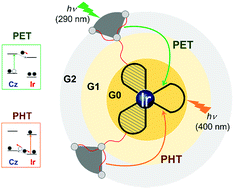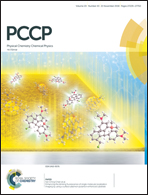Photoinduced electron and hole transfers in carbazole dendrimers with heteroleptic Ir-complex cores†
Abstract
We synthesised carbazole (Cz) dendrimers with heteroleptic Ir-complex cores. Upon excitation of the carbazole (Cz) dendrons, the phosphorescence of the core Ir(III) complex was quenched due to the photoinduced electron transfer (PET) process. The PET dynamics of the excited Cz-dendrons were investigated using the femtosecond time-resolved transient absorption technique. A broad transient absorption (TA) band attributed to the S1–Sn transition of the 1Cz*-dendron was observed at around 630 nm in the first generation Cz-dendrimer (G1). This TA band in the second-generation dendrimer (G2) decayed with a longer lifetime of 55.5 ps compared to that of G1 (9.8 ps), because G2 has a larger distance between the Cz-dendron and Ir-complex core than that of G1. The decay time of the free 1Cz*-dendron was 6.3 ns, and thus, the reduced decay time in Gn corresponds to the PET dynamics. As a result of the PET process, the Cz cationic radical species (Cz˙+) was observed at around 780 nm. Interestingly, when the core Ir-complex in the dendrimer was excited with a 400 nm pulse selectively, the TA band of Cz˙+ was also detected at around 780 nm. This may be due to the photoinduced hole transfer (PHT) from the highest occupied molecular orbital (HOMO) energy state of Cz to the lowest singly occupied molecular orbital (LSOMO) energy state of the excited Ir-complex. The oxidation potential of Cz is lower than that of the Ir-complex, indicating that the HOMO of the Cz-dendron is located at a higher energy state than that of the Ir-complex. To investigate the relative order of the energy states and their orbital shapes, we performed theoretical calculations using density functional theory. The TA spectra were globally deconvoluted to generate the decay-associated spectra (DAS), from which the species-associated spectra (SAS) were calculated. The SAS can distinguish the individual intermediate species participating in the PET and PHT processes. The analysed rate constants of SAS were consistent with the results determined by the TA decays.



 Please wait while we load your content...
Please wait while we load your content...